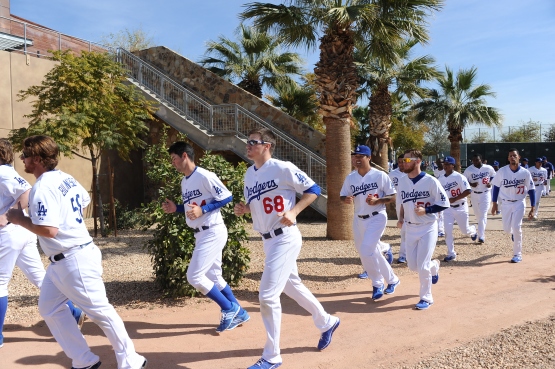[milbvideo id=”27230273″ width=”550″ height=”308″ /]
By Jon Weisman
Right-handed pitching prospect Garrett Gould, the Dodgers’ second-round draft choice in 2009, had Tommy John surgery in November but said “everything is going great” with his recovery.
“I’ve just about gotten all of my range of motion back, so now I’m trying to strengthen my arm and get it moving again,” Gould said Friday. “It’s been tough knowing that I might not play baseball at all this year, but it’s something I try not to think about. Right now I’m just trying to do what my trainers ask and work hard every day to get back on the field as soon as possible.”
Gould never really got untracked in 2014, finishing his season in June with a 7.34 ERA, 1.78 WHIP and 41 strikeouts in 61 1/3 innings.
“I’m not sure exactly (when it happened), but I knew something was wrong for a little while,” Gould said, “but I thought it was something that I could pitch through and be all right.”
“I started my rehab down in Arizona with our trainers, and now I’m doing it at a place back home in Wichita,” he said. “I’ll be heading back to Arizona at the start of February to continue it down there with our trainers.”
During his time in Arizona, Gould has crossed paths with minor-league teammate Ross Stripling, who had Tommy John surgery in April. The 25-year-old Stripling, who had a 2.78 ERA with 83 strikeouts in 94 innings for Double-A Chattanooga in 2013, said that he has done the majority of his rehab in Frisco, Texas — in the Dallas metropolitan area.
“I just passed nine months, so I’m in the stage where I’m about to really start ramping everything up,” Stripling said Friday. “I took the holidays off — I was in Arizona right before Christmas, and that’s when I started flipping a couple of curveballs and changeups for the first time. Everything went great with that.
“I started throwing again two days ago. Pretty much from here on out, I’ll gradually start increasing the intensity of how hard I throw and how much I throw: curveball, slider, changeups, everything.”
Stripling compared the initial stage of rehab to a running back coming back from a torn ACL.
“To make a cut at 100 percent, you don’t have the confidence,” Stripling said. “The first time you go out, you don’t have the conference to throw as hard as you want, whenever you want. It took me a week to 10 days before I really trusted my elbow. That was kind of a funny step for me.”
In joining baseball’s long line of Tommy John patients, Stripling has become a conduit of information and advice. Scott Elbert, for example, was there for Stripling, and Stripling was there for Gould, helping navigate the protracted rehab.
“It’s such a long process, and everybody says it’s as much of a mental grind as a physical grind,” Stripling said. “You’ll wake up, four to five months after surgery, and you’ll feel healthy, feel strong, wonder why you have to wait for a year.
“You’ll have days where you think you can go out and throw seven innings, and days you think you’ll never throw a baseball again. Every day is different.”
In an April Dodger Insider magazine story, Dodger vice president of medical services Stan Conte discussed the importance of monitoring a pitcher’s throwing speed during rehab.
“We actually use a radar gun to keep the velocity where we want him,” Conte said. “There’s a mathematical relationship between increased velocity and increased stress on the ligament. They’re vulnerable to throwing too hard and actually damaging the repair.”
And so there’s nothing to be gained by rushing through the process. Stripling said he was told by Dodger minor-league medical and rehabilitation coordinator Nick Conte to err on the side of caution.
“We have a year or even more to get healthy, so if something doesn’t feel right, there’s really no need to push through it,” Stripling said. “Especially since I’m a starter, I have to be able to pitch six or seven innings, not just one. Your main focus is just to get healthy.”
In the winter, contact with his teammates has been rare, though he did attend November’s Kershaw’s Challenge event in Dallas. He’ll be eager to reunite with fellow players at Camelback Ranch.
“It’ll be a blast, man,” Stripling said. “The Dodgers were great – they let me do half my rehab in Texas, and all my friends and family are there – but I’m missing it.”





Comments are closed.